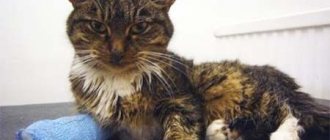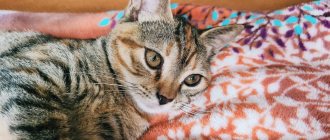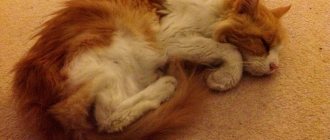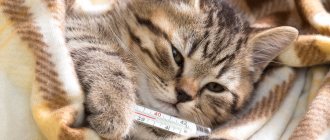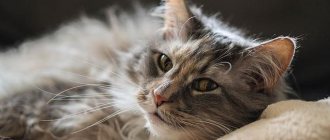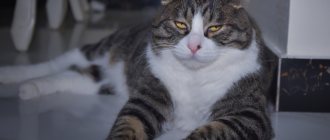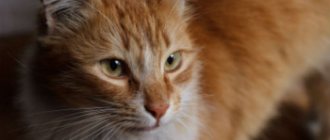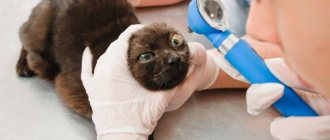Heart failure is a condition in which the heart is unable to provide sufficient blood flow. As a result, organs and tissues suffer from oxygen starvation and nutritional deficiency. In severe cases, the pathology leads to death. Depending on the speed of development of symptoms, heart failure in cats is divided into acute and chronic.
Acute heart failure in cats, symptoms
Symptoms appear suddenly and the condition worsens quickly, over several hours and sometimes minutes. At the first sign of acute heart failure in a cat, it should be taken to a veterinarian immediately.
Symptoms:
- Shortness of breath, breathing is frequent and shallow, the cat breathes mainly from the stomach.
- The animal may become restless and meow loudly; in severe cases, severe depression develops, even to the point of loss of consciousness.
- Blue discoloration (cyanosis) of the mucous membranes.
- The limbs are cold.
- With the development of pulmonary edema, breathing becomes heavy, with moist rales.
- Due to the detachment of a blood clot, paralysis of the pelvic limbs may develop.
Signs
Typical symptoms:
- dyspnea;
- difficulty breathing, suffocation;
- wheezing;
- weakness, lethargy;
- weak pulse;
- pale mucous membranes;
- the appearance of pink foam from the mouth.
It is not typical for cats, unlike dogs, to breathe with their mouths open even in the heat or during physical exertion, this is important to remember. Cats are sprinters, they are adapted to high, but very short-term loads, in contrast to dogs, adapted to long-term endurance loads. If a cat breathes with its mouth open even after minor exertion, this is a reason to take it to a cardiologist for a full examination. If this is accompanied by other symptoms - weakness, lethargy, change in color of the mucous membranes (turn pale, blue, purple), it is necessary to urgently take her to the clinic in the intensive care unit.
Causes
The main causes of heart failure in cats:
- Hypertrophic cardiomyopathy - the myocardium grows inward, resulting in a decrease in the volume of the heart chambers. A very common pathology in some cat breeds.
- Severe stress.
- High blood pressure.
- Inflammatory and degenerative pathologies of the myocardium.
- Hyperthyroidism.
- Infectious and invasive diseases.
- Long-term lack of taurine in the diet.
- Oncological diseases.
- Congenital heart defects – patent ductus botallus, pathologies of valves, cardiac septa.
Main symptoms
Symptoms, signs, and clinical manifestations of cardiac pathologies are ambiguous. The general picture, the intensity of symptoms depends on age, conditions of detention, the presence of secondary, concomitant systemic diseases, general physiological condition, individual characteristics, form, and the root cause of the disease.
Often, owners detect symptoms of heart disease when they enter the chronic stage, which can end tragically for their pet. Therefore, always carefully monitor the behavior and condition of your furry pet, and if there are any signs of discomfort or worsening of the condition, contact a veterinarian.
Important! Pathologies and diseases of the cardiovascular system can manifest themselves in cats of different age groups. Heart diseases are not always detected in elderly, old animals.
Signs of heart disease and pathologies in cats:
- weakness, decreased activity, lethargy, drowsiness;
- weak reaction to external stimuli;
- refusal to eat;
- heart rhythm disturbances (arrhythmia, tachycardia);
- fainting, signs of suffocation;
- breathing problems (shortness of breath, rapid breathing, cough);
- wheezing in the sternum, wheezing;
- pallor, cyanosis of mucous membranes;
- swelling on the body, ascites;
- dry nose;
- heart murmurs on auscultation;
- weight loss;
- fainting, convulsions, muscle spasms;
- temperature drop;
- violation of movement coordination.
Cats suffering from heart pathologies get tired quickly after active games or short activity. Animals may take unnatural positions and refuse food or treats offered.
Touching the sternum causes pain. Breathing is rapid (more than 35-40 breaths per minute at rest), shallow. Respiratory rate is measured by chest movement.
Important! The respiratory rate of cats is affected by weight, age, ambient temperature, and the condition of the animal. Thus, in pregnant and lactating cats, and in pets after physical activity, the respiratory rate is increased.
Due to oxygen starvation, animals stretch their necks forward and breathe with an open mouth. Cats often have swelling in their limbs and muzzle. Body temperature is unstable and in most cases low.
Heart pathologies in cats often cause convulsions, which are in many ways similar to epileptic seizures. Animals with heart failure try to move as little as possible and avoid physical activity. Possible loss of coordination of movements, frequent sudden fainting caused by dizziness, paralysis of the hind legs.
Given the non-specificity of symptoms, it is very important to carry out comprehensive diagnostic measures in the clinic as quickly as possible. Diagnosis of heart pathologies in animals is quite complex, is carried out using special equipment and requires highly qualified veterinarians.
Heart failure in cats treatment
For acute heart failure in cats, treatment includes:
- Oxygen therapy - the animal is placed in an oxygen chamber, if the clinic equipment allows - oxygenation of the blood is carried out (its direct saturation with oxygen using a special device).
- Providing the animal with maximum rest.
- Intravenous administration of cardiac glycosides, diuretics, steroids, energy substrates, soda solution, electrolytes, antibiotics.
- Symptomatic therapy - the prescription of manipulations and drugs that eliminate the cause of heart failure.
- Maintenance therapy - the use of vitamins, immunostimulants, nutrient solutions.
- If diuretics are insufficiently effective and fluid accumulates in the body cavities, it is pumped out through a puncture.
By eliminating the cause of the pathology and providing timely assistance, it is possible to avoid irreversible changes in the animal’s body. In some cases, the acute process becomes chronic.
For chronic heart failure, treatment is often lifelong and includes:
- A therapeutic diet.
- Normalizing body weight, minimizing situations that can cause stress.
- Prescribing medications to thin the blood, normalize blood pressure, increase heart contractility, diuretics, potassium and magnesium supplements, and vitamins.
Diagnostics
At the appointment, the doctor assesses the patient’s condition (quality of pulse, heart rate, presence of wheezing in the lungs, color of mucous membranes). To clarify the diagnosis, a chest x-ray is taken. Next, the animal is placed in the intensive care unit, where a complex of resuscitation measures is carried out.
Mandatory laboratory diagnostics include general clinical and biochemical blood tests.
A complete cardiac examination is carried out only after the patient has been stabilized and necessarily includes echocardiography of the heart.
Prevention
It is impossible to completely eliminate the risk of developing pathology. Significantly reduce the likelihood of its occurrence:
- Proper feeding.
- Absence of factors that cause stress in the cat.
- Examination by a veterinarian every year, if the breed of the animal predisposes to the disease - every 6 months.
- Exclusion from breeding of animals with a history of congenital heart pathologies.
Pet owners need to know that a number of heart pathologies, such as feline hypertrophic cardiomyopathy and some others, may not manifest themselves for a long time. But if the animal’s body is subjected to stress, including anesthesia, cardiac pathology can become threatening to the normal existence and even life of the cat. Therefore, before carrying out planned surgical interventions, it is very important to undergo a cardiac examination (Ultrasound of the heart), during which hidden cardiac pathologies of cats, if any, will be identified.
You can read more about the importance of cardiac examination of animals in the section Heart ultrasound and Cardiology.
In our clinic, cardiology appointments are conducted by doctors Lidiya Mikhailovna Biryukova and Olga Vladimirovna Evstifeeva.
Types of Heart Diseases
Heart disease can be congenital or acquired. At the same time, they are all united by gradual progression. Heart diseases can be acute, subacute, or chronic.
Birth defects
Some heart diseases and pathologies in cats are congenital and hereditary. However, they are not common, only in 2.5-4% of kittens. The most commonly diagnosed malformations of the heart valve are septal openings.
These pathologies include:
- stenosis (narrowing) of the aorta;
- stenosis of the ventricular efferent valve;
- defects of the interventricular and intervalvular septa;
- pulmonary stenosis;
- triatrial heart;
- endocardial fibroelastosis.
Important! Congenital heart pathologies manifest themselves at young and older ages. It all depends on the care, conditions of detention, individual, physiological parameters
Defects in the development of the valve apparatus are detected at the mitral valve, which is located between the left ventricle and the left atrium. If the valve does not close properly, its functioning is impaired, blood does not flow into the atrium, which will lead to malfunction of the heart and accumulation of blood between the chambers of the organ.
Symptoms of congenital heart pathologies vary depending on the specific disease. Anemia of the mucous membranes and skin, excessive thirst, irregular heart rhythm, respiratory failure, weakness, drowsiness, increased thirst, decreased activity - these are the main manifestations of congenital heart pathologies in cats.
The prognosis for congenital heart pathologies is in most cases unfavorable. Drug treatment provides improvement, but animals, if there are no contraindications, are prescribed surgery.
Heart pathologies
It is simply impossible to consider heart pathologies that are diagnosed in cats in one article. Each disease requires special attention and review. Therefore, let’s imagine diseases that are diagnosed in veterinary medicine.
Cats are diagnosed
- pericarditis (inflammation of the pericardium);
- myocarditis;
- myocardosis (dystrophy of the heart muscle);
- cardiac arrhythmias, which, although not the main disease, indicate malfunctions of the cardiovascular system.
One of the common pathologies is endocarditis . Manifested by inflammation of the inner lining of the muscle. It occurs acutely and chronically. Depending on the localization of the process, it can be parietal (verrucous), valve (ulcerous). The nature of the changes is warty, ulcerative.
Pericarditis in cats is often idiopathic. The pathology is accompanied by impaired blood flow, destructive, dystrophic, necrotic processes in the tissues of the organ.
Causes of pericarditis: hypothermia, weakened resistance, overwork, frequent stress. The initial stage is characterized by fibrin deposition, the formation of adhesions, and cardiac murmurs. Dry pericarditis in cats often turns into an exudative form. Parenchymal edema of organs and intoxication due to exposure to toxic products gradually develop.
Symptoms depend on the stage of development:
- tachycardia is noted;
- tachysystole;
- fever;
- pain in the heart area;
- symptoms of dehydration.
Arrhythmia, tachycardia, and other heart rhythm disturbances are not a separate pathology, but a symptom, a manifestation of some pathology or a consequence of inflammatory processes.
Treatment for any pathology is aimed at normalizing heart function, adjusting blood pressure, and eliminating the root cause.
Consequences
After a certain amount of time, the heart weakens until it can no longer contract strongly enough. This causes the volume of blood released into the systemic circulation to decrease.
The heart muscle tissue slowly dies and is replaced by scar tissue. Decreased blood output in the long term can lead to several consequences. Initially, patients notice swelling in their legs and experience shortness of breath. The supply of nutrients and oxygen to the body decreases, and then this is observed at rest.
